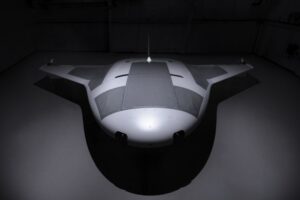Northrop Grumman [NOC] on Monday said it completed the assembly of the Manta Ray uncrewed underwater vehicle (UUV) prototype.
Manta Ray is a new class of extra-large UUV gliders that are designed to operate for long durations, at long range, and with undersea mission payloads while not requiring on-site human logistics.
In 2021, the Defense Advanced Research Projects Agency (DARPA) awarded contracts to Northrop Grumman and the Martin Defense Group to move to Phase 2 in the Manta Ray UUV program (Defense Daily, Dec. 21, 2021).

Phase 1 of Manta Ray began in 2021 with the participants designing and conducting preliminary testing on “novel approaches” to energy management, UUV reliability, navigation and undersea obstacle avoidance.
In Phase 2, the companies worked on subsystem testing before moving to fabricate a full-scale model for use in water demonstration, like here.
Metron, Inc. has also been working on an energy harvesting subsystem under novel energy management techniques, one of the key technologies listed by DARPA for the vehicle.
Northrop Grumman noted DARPA’s program here seeks to advance technologies for future UUVs, like techniques to manage energy, increase payload capacity and low-power propulsion.
The company built the vehicle at its Annapolis, Md., facility.
A DARPA website about the program said, if successful, this new Manta Ray class of UUVs “will give the combatant commander an amplification of capacity without disrupting current operations by remaining independent of manned vessels and ports once deployed.”